See how marketing mix modeling works, why it matters, and how to set it up to get better insights.
Marketing mix modeling is making a comeback in the world of digital marketing.
As tracking becomes less reliable and third-party cookies fade out, marketers are finding it increasingly difficult to measure the effectiveness of their marketing campaigns.
MMM has been rediscovered as a way to overcome these challenges by providing marketers with a more holistic view of their marketing performance.
There’s no doubt that MMM will play a key role in the future of marketing measurement. If you’re a marketer, now is the time to start learning about and adopting this technology—and this article will help you get a head start.
Here’s what you’ll learn:
💡 Pro Tip
Chances are you’re here because you’ve considered using marketing mix modeling. If so, why not give Ruler Analytics a look? Ruler takes the best of marketing mix modeling and multi-touch attribution to give you the bigger picture and help you understand the factors that affect your sales, deals and ROI.
Book a demo to see Ruler’s MMM in action
Marketing mix modeling (MMM) is a statistical tool that helps companies understand how each part of their marketing impacts customer behaviour, sales, and ROI.
The term “marketing mix” was first introduced back in the 1960s, and MMM as an in-depth analytical method took off in the 1980s and 90s.
Lately, MMM has seen a revival in the digital world as marketers navigate issues like Apple’s privacy updates, walled-off data, and the decline of third-party cookies.
MMM lets you break down your performance by channel, so you can see which marketing tactics are really moving the needle.
It brings in various types of data to evaluate the effectiveness of your marketing. Some of the core data it considers includes:
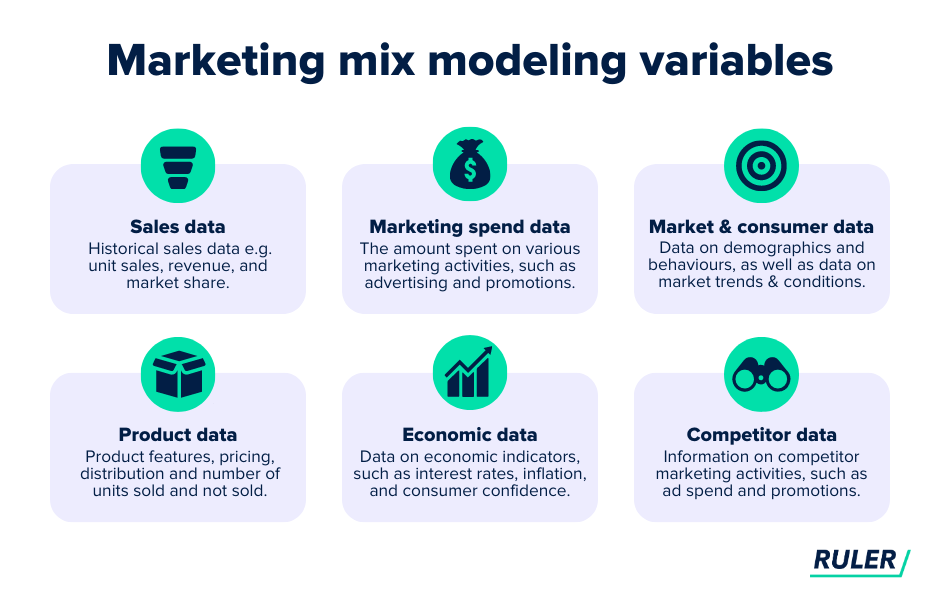
Let’s take Ruler’s marketing mix modelling, for example.
Ruler’s MMM uses the data sources listed above to show the impact of different marketing touchpoints and identifies the point at which additional investment in a marketing channel will no longer result in a proportional increase in sales or revenue.
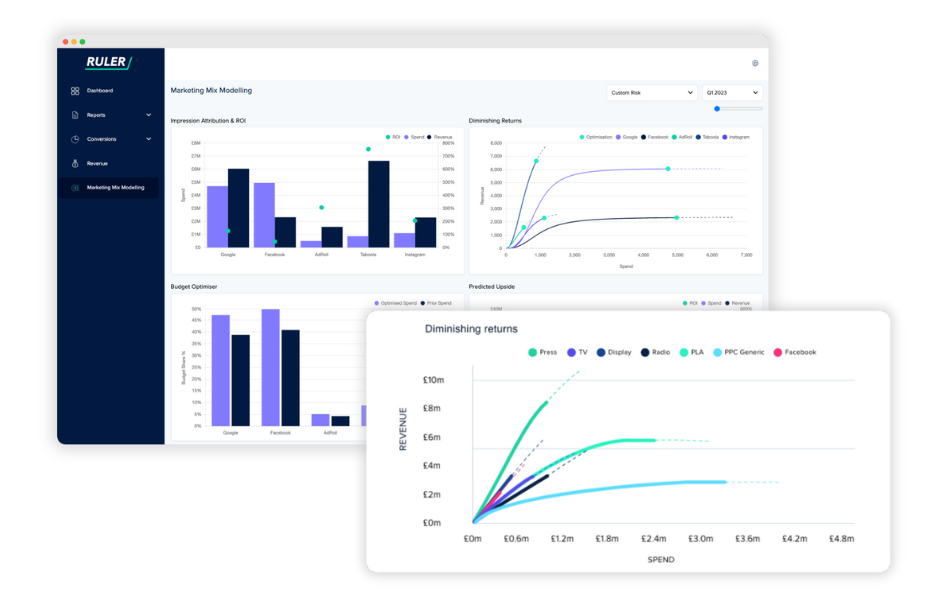
While it may seem like doubling your PPC ad spend from £0.6m to £1.2m would double your conversions, in reality, your returns will likely diminish as you increase your ad spend.
This is because there is a point at which additional investment in PPC will no longer result in a proportional increase in conversions.
Diminishing returns is just one benefit of MMM too. Other benefits include the ability to:
More on Ruler shortly, first let’s take a deeper dive into how the concept of MMM works…
💡 Skip ahead to the demo
If you’re ready to learn how Ruler can help you improve your marketing ROI, book a demo and see for yourself all the good stuff we have to offer.
Chat with us and see Ruler in action
Marketing mix modeling (MMM) uses multiple linear regression (MLR) to analyse the relationship between business results (like sales) and different marketing activities.
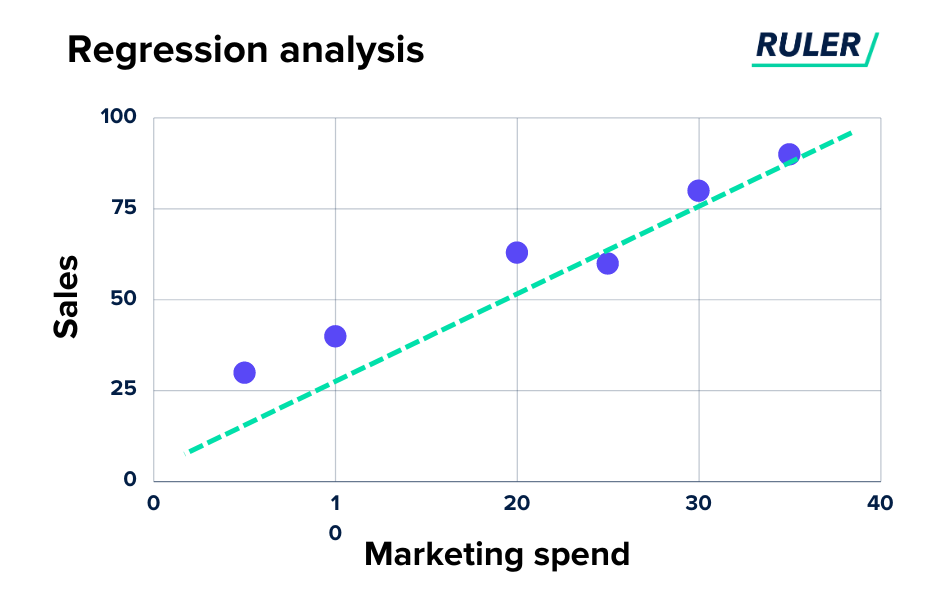
In MLR, you’re looking at how one or more independent variables (like advertising spend or price) impact a dependent variable (like sales or revenue). This helps estimate how changes in marketing tactics could affect future business outcomes.
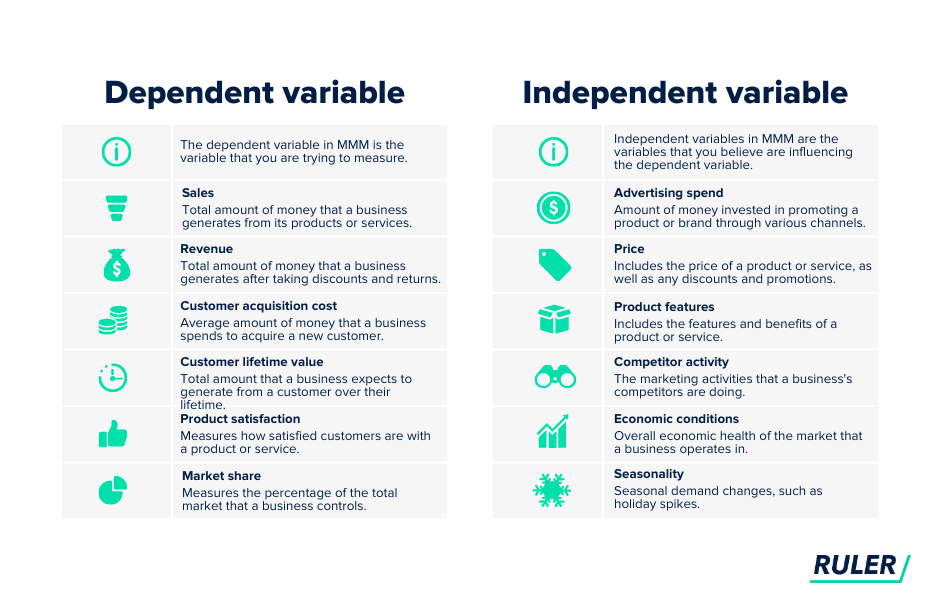
In MMM, the dependent variable is usually a business metric we care about, like:
Independent variables in MMM are the marketing activities or factors that might drive those results, such as:
While MLR is commonly used, other methods like time-series analysis, logistic regression, or even machine learning can be applied, depending on the needs of the analysis.
By now, you might be wondering why marketing mix modeling is even worth your time.
After all, you likely already have tracking set up—whether through Google Analytics or metrics from your ad platforms. But, there are several important reasons to consider it.
Gone are the days when businesses could rely on a single marketing channel to drive growth.
Today’s customer journey is anything but straightforward—people are browsing ads on Meta, searching for solutions on Google, and diving into product reviews on TikTok.
Marketing across these different channels is crucial, but stitching those journeys together to understand the impact of each touchpoint is a big challenge.
Many traditional tools, like Google Analytics, are click-based, use first-party cookies, and have limited lookback windows, which falls short for mapping out complex customer journeys over time.
On top of the already challenging journey mapping, tracking data has gotten trickier, especially on Safari, thanks to Apple’s Intelligent Tracking Prevention (ITP).
With ITP, first-party cookies now only last 1-7 days, depending on user settings.
Combine this with Apple’s App Tracking Transparency (ATT) rules, which force developers to ask permission before tracking activity across apps and sites, and it’s clear that the ways we used to measure marketing success are getting muddied.
To make things tougher, Google Analytics doesn’t capture essential data like media channel performance, ad impressions, or ad spend’s impact on revenue—making it harder to get a clear view of what’s actually working.
Of course, privacy isn’t just about policies and browser settings.
People are actively taking control, using tools like ad blockers to stop tracking in its tracks. Ad blockers don’t just keep annoying ads at bay; they also limit the data companies can collect on user behaviour.
Combined with regulations like GDPR and CCPA, these trends mean marketers have less data and less clarity on their campaigns. For businesses, it’s a whole new landscape that requires creativity and adaptability to measure success effectively.
Marketing mix modeling sets out to combat these issues and helps tackle the tricky parts of tracking by showing marketers what’s working at every stage of the funnel. It makes sure the right channels get credit and budgets are spread out fairly.
Marketing mix modeling (MMM) and marketing attribution are often compared but are actually quite different. They both evaluate marketing’s impact, but their approaches vary a lot.
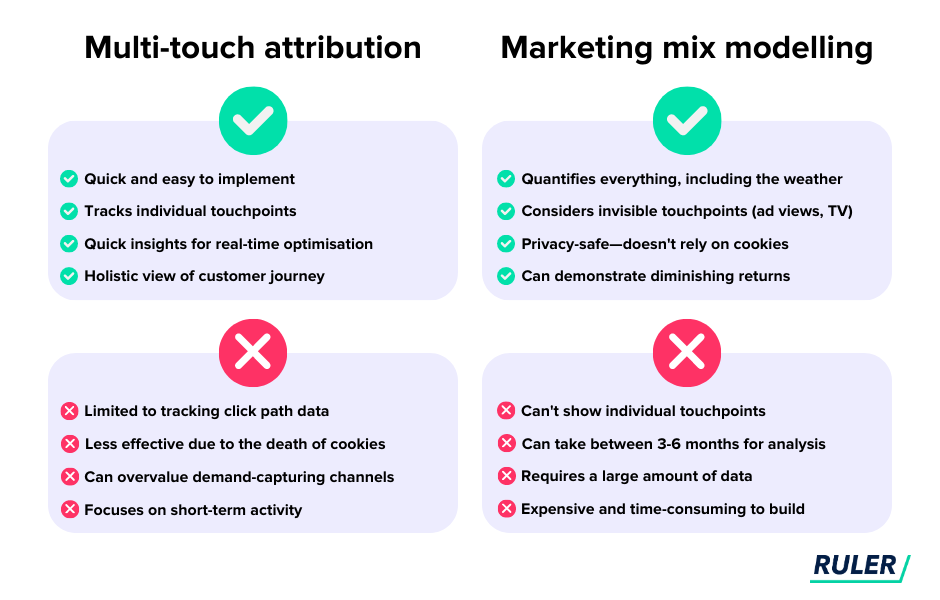
Marketing attribution software assigns credit for sales or conversions to the marketing touchpoints that influenced the customer’s journey—ads, emails, site visits, etc. Multi-touch attribution (MTA) specifically spreads credit across multiple touchpoints to highlight which interactions were most effective.
We’ve already covered MMM and how it works, but MMM is a statistical analysis of how various marketing activities (both online and offline) impact overall sales and business metrics.
But there’s one thing we haven’t yet pointed out.
MMM uses a broader approach to marketing measurement and often incorporates marketing attribution as one of the inputs in its analysis. So you can think of marketing attribution as a subset of MMM.
Marketing attribution information can be used in MMM to better understand the effectiveness of different marketing channels and how they work together to drive sales.
To get started with MMM, you need to gather and organise your data, decide which models to use, and set up the system.
These steps typically include:
These steps sound simple, but in practice, it’s quite difficult to set up successfully, especially if you’re new to the principle of marketing mix modeling.
Another option is to invest in an attribution and MMM solution. It’s less complicated and often more cost-effective than having to hire a statistician to build a marketing mix modeling system from scratch.
Take Ruler Analytics, for example.
Ruler takes the best of multi-touch attribution and marketing mix modeling to help you better understand your marketing performance and identify areas to prioritise.
It lets you see how all of your channels (online and offline) are performing and how well they can be attributed to conversions and sales.
Ruler starts by tracking the entire customer journey at the visitor level on a first-party basis.
It captures the marketing source from each session, page views, UTM variables, Click IDs, and Cookie IDs which are then matched to a lead driven from a form, phone call or live chat.
Ruler passes the marketing source data you’ve captured on your leads to your CRM and other marketing tools. This allows you to enrich your leads and opportunities with attribution data so you can see exactly how your marketing impacts pipeline generation.

When a lead is marked as closed as won, the revenue data is sent back to Ruler. With revenue and opportunity data in Ruler, you can easily measure and validate the impact of your marketing sources, campaigns and keywords.
Now, let’s talk about its MMM.
Ruler uses marketing mix modeling alongside its multi-touch attribution to give you the bigger picture and help you understand the factors that affect your sales and ROI.
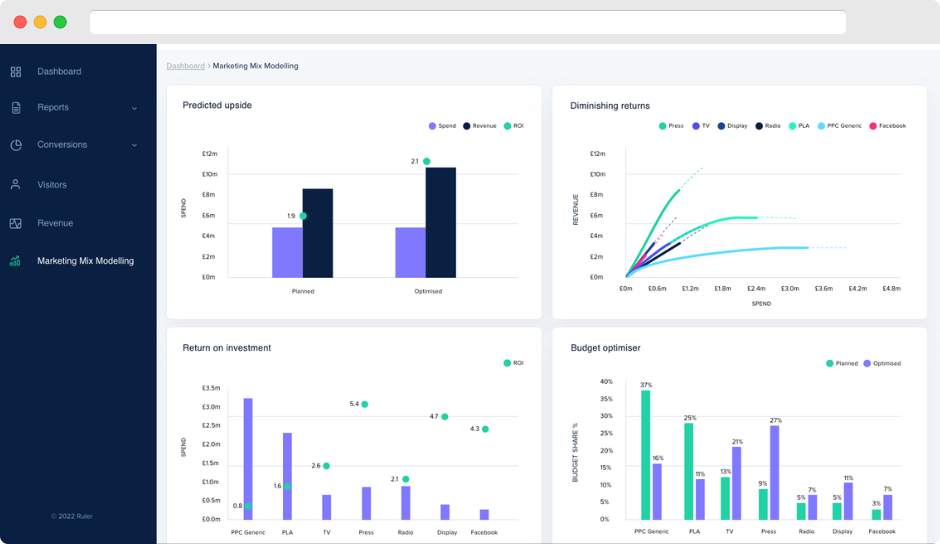
Here’s a breakdown of the five key features in Ruler’s MMM:
Predicted Upside: The budget optimiser also shows the impact of these adjustments on your revenue. For example, a reallocated budget might add £1.3 million in sales, bumping your ROI from £1.9 million to £2.1 million.
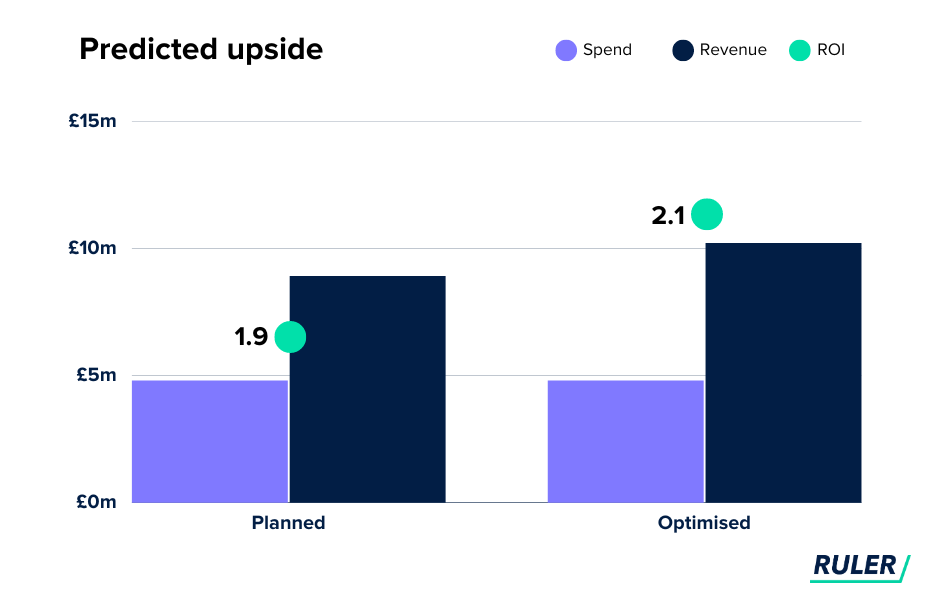
Book a demo of Ruler to see it in action for yourself here.
With marketing mix modeling set up successfully, you’ll have data linking your sales to your marketing efforts.
You’ll be able to see a clear picture of your marketing wins (and losses), so you can improve and optimise your marketing strategy for maximum results.
If you’re looking for a marketing reporting system that unifies data across online and offline channels and links your conversions directly to revenue, then Ruler is for you.
It allows you to access revenue data and link it directly to your marketing activities without any of the headache of doing it yourself.
